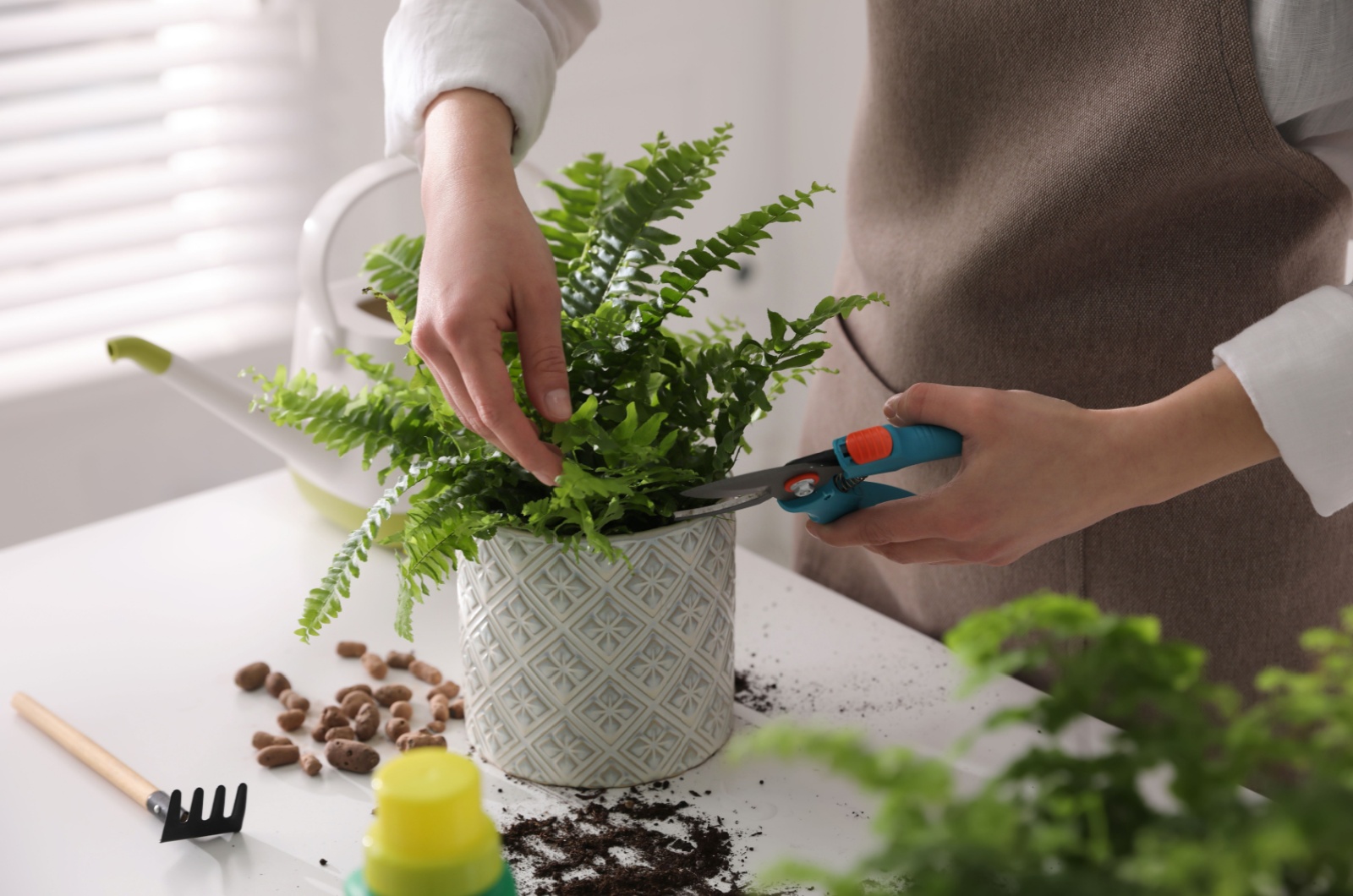Boston ferns are popular leafy plants that instantly add life to any space – both indoors and outdoors!
They are relatively low-maintenance and can adapt to various growing conditions, which is why many gardeners love them (besides the obvious aesthetic reasons).
However, these plants can’t handle frost, so if you live in a colder area (below zone 9), you’ll need to help them survive those freezing temperatures.
Luckily, it’s super easy!
These are the steps you need to take to keep your fern happy and healthy until spring:
1. Bring Your Boston Fern Inside
The first thing to do when getting your Boston fern ready for winter is bring it indoors – these ferns love being inside, so it’s a pretty easy move!
If it’s already in a pot, just bring it in before frost. If it’s in the ground, carefully dig it up, put it in a pot, and move it inside (be gentle with those roots!).
You should also check for any bugs that might be hiding in the leaves before you bring it inside – I bet you don’t want pests spreading to your other indoor plants!
Once it’s safe inside, treat it like any other houseplant. Keep it in a bright room that stays cool (around 63-72°F). Also, make sure it’s not near any heaters or drafty windows because that could dry it out quickly.
2. Rotate Your Fern Regularly
Boston ferns are natural light-seekers, and in winter, they might not get the full, even sunlight they need. To keep your fern looking its best and avoid it becoming one-sided, simply rotate it every two weeks. It’s a quick fix that goes a long way!
Even when the sunlight is playing hard to get, rotating your fern ensures every frond gets its fair share of the spotlight, promoting more even growth.
This simple step will help your fern weather the winter storms, coming out stronger and ready to bloom once spring rolls around.
3. Keep The Air Moist For A Happy Fern
Your fern will appreciate a little extra moisture in the air during the colder months. To achieve this, you can group it with other plants – this creates a mini rainforest effect.
If a humidifier isn’t in the cards, try placing your fern on a pebble tray filled with water. As the water slowly evaporates, it creates a moisture-rich atmosphere that your fern will love!
4. Trim Off Any Damaged Leaves
Bringing it indoors is not the only thing we are supposed to do to prep them for winter – you should also give your fern a little trim before it gets cold.
All you have to do is trim off any dry or browning fronds from the top and cut older fronds near the base to about 3-5 inches. Just be careful not to cut those fresh, young fronds.
And remember, don’t go overboard. Cutting more than a third of the plant can stress it out (don’t ask me how I know this).
A good trim helps get rid of dead leaves and encourages fuller growth once spring arrives.
Always use sharp, clean tools – something like bypass pruning shears can make the job a lot easier!
Related: Use These Methods To Propagate Boston Fern
5. Use A Light Fertilizer Sparingly
When winter rolls around, your Boston fern doesn’t need a feast – it just needs a light snack! With its growth slowing down, it’s not the time for a heavy dose of fertilizer.
Instead, use a mild, balanced fertilizer diluted to half the recommended strength, applying it just once a month.
This way, your fern gets the perfect amount of nutrients to stay strong without overwhelming its natural rhythm. Just remember: a little goes a long way!
6. Don’t Water As Much
Like most plants in winter, your Boston fern won’t be as thirsty as it is in the warmer months, so it’s important to cut back on watering.
Since they aren’t actively growing, too much water can do more harm than good.
But if you do keep watering the same as you did during the summer, your plant might suffer from root rot (that can completely ruin it).
They also don’t like for their soil to be completely dried out, so balance it well!
I personally use a soil moisture meter (Amazon has some great ones) to make sure my plants stay happy, though watering them once every 3-5 weeks should be enough.
7. Check Your Fern For Hidden Pest
Boston ferns are stunning plants, but even the most beautiful green companions can have their share of troublemakers – pests! When winter rolls around and your fern is nestled indoors, it’s more vulnerable than ever. That’s why you’ll need to keep your eyes out for subtle signs of trouble.
If you spot tiny, discolored spots on the leaves or the edges turning brown, it might be a signal that pests are sneaking up on your Boston fern! A sticky residue or shiny film could mean aphids or mealybugs are feeding on your fern’s precious leaves.
Tiny webs? Spider mites could be the culprits, silently weaving their homes on the undersides of your fronds. And don’t forget scale – those sneaky little bumps on the stems that are easy to miss but hard to ignore once they spread.
So, what can you do to get rid of them? Don’t panic – there are several natural, effective solutions to send these pests packing. You can use neem oil or insecticidal soap, both of which, in my case, turned out to work great!
8. Add A Light Layer Of Mulch On The Soil Surface
A light layer of mulch on the soil surface can work wonders for your Boston fern during winter.
Think of mulch as a protective shield, helping to lock in moisture and regulate the temperature around your plant’s roots. As the temperature drops, the mulch acts as an insulator, keeping the roots warm without overheating them!
Materials like pine bark, shredded leaves, or coconut coir are ideal for this task. They not only retain moisture but also provide a natural look that complements your fern’s aesthetic.
A good mulch layer prevents moisture from evaporating too quickly, which is especially important when the indoor air gets dry. Without mulch, your fern might dry out faster than you’d like, requiring more frequent watering.
But with mulch in place, it’s much easier to maintain consistent soil moisture. This helps your fern stay hydrated and reduces the chances of it becoming stressed during the colder months.
When applying mulch, keep it to a thin layer – about one to two inches. Too much mulch can block airflow and lead to mold or rot, which is a problem you want to avoid!
A light, carefully applied mulch layer ensures your Boston fern stays healthy, hydrated, and snug throughout the winter, making it an essential part of your care routine.
9. Provide It With Good Insulation
Boston ferns aren’t exactly fans of the cold, so even indoors, a cooler room (like a garage or conservatory) can still affect their health.
One trick I’ve found handy is wrapping the pot with burlap – it will keep the roots nice and warm during the colder months. However, you could also use straw or frost-protection fleece to insulate the pot (anything to keep your fern cozy until spring).
For an extra layer of protection, try placing your fern on an insulated surface like a foam mat or a cozy wooden tray to shield it from the cold floor below.
Keeping the roots warm is key, so take a moment to check the soil temperature – fluctuating temps can stress your fern more than you might think! By reducing its exposure to the cold, you’re setting your fern up for success.
Also read: Asparagus Fern Turning Yellow: 5 Common Problems And Solutions
10. Move It Back Outdoors When The Weather Gets Nicer
Once you’ve successfully grown your Boston fern through the winter, you should put them back outdoors as soon as the weather gets nicer.
Wait until the last frost has passed and the temperatures at night are around 65°F (anything below would be too cold for your precious fern).
Also, don’t forget to ease your fern back into outdoor life. Just like houseplants, it’ll need time to adapt to its new surroundings.
Start by placing it in a warm, shaded area to avoid leaf scorch and then bring it back to the place where it was before.
So, follow these steps and your Boston fern will be ready to enjoy many more springs!
Also read: These Are The 10 Houseplants You Should Move Outside For The Summer To Unleash Their Full Potential











